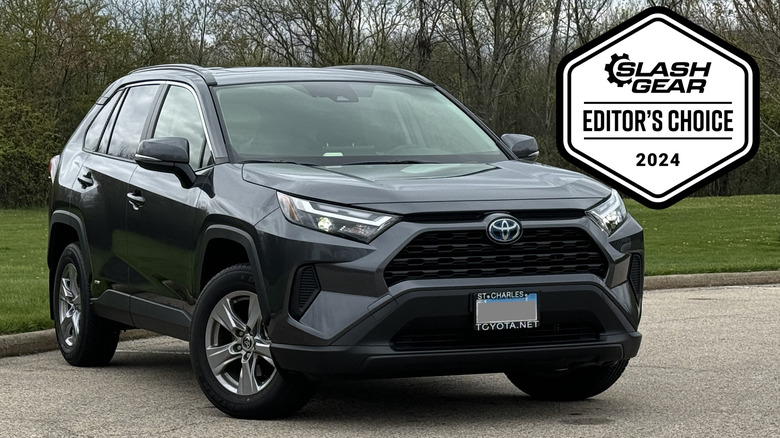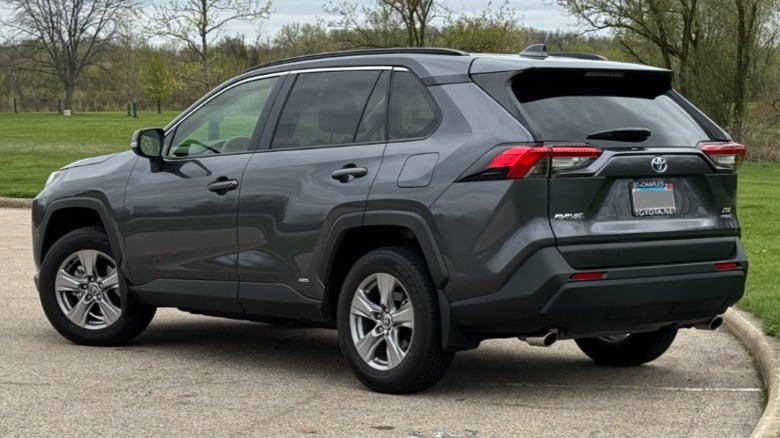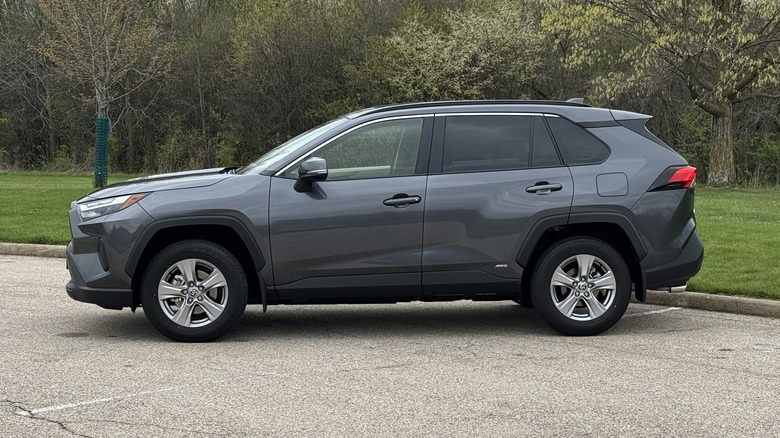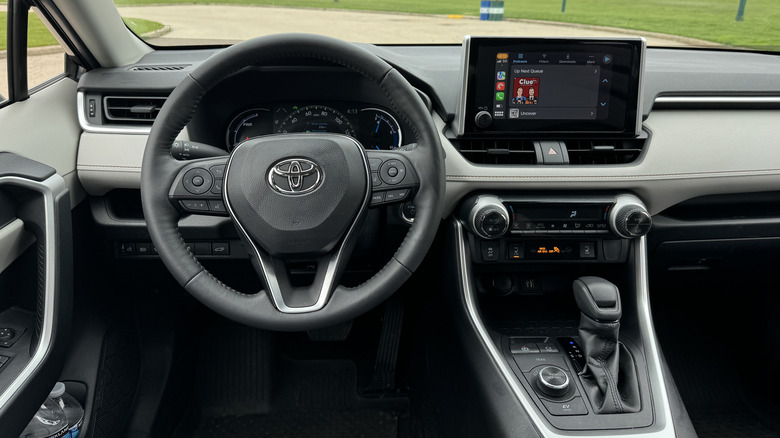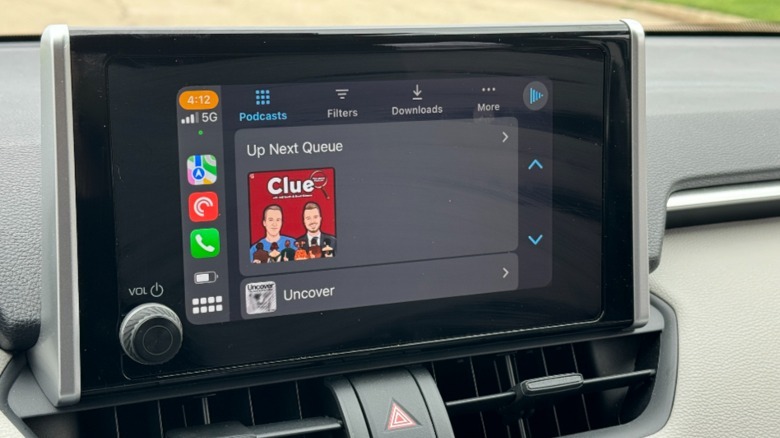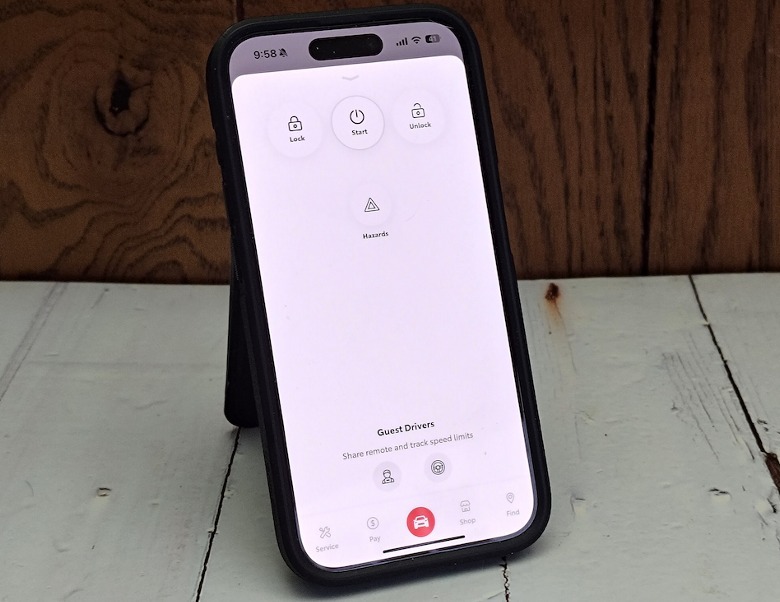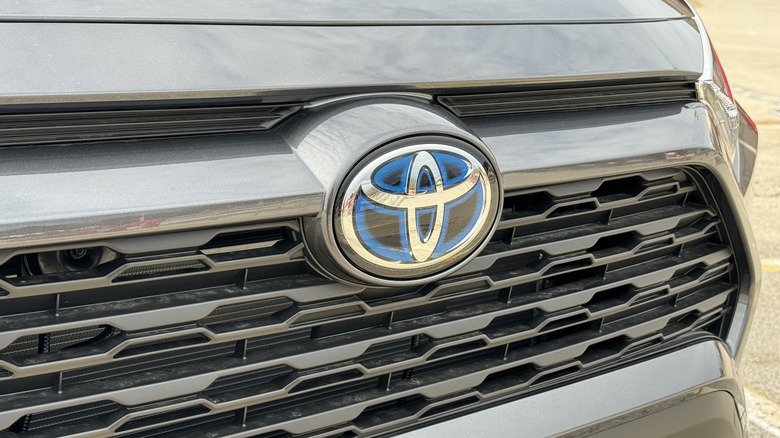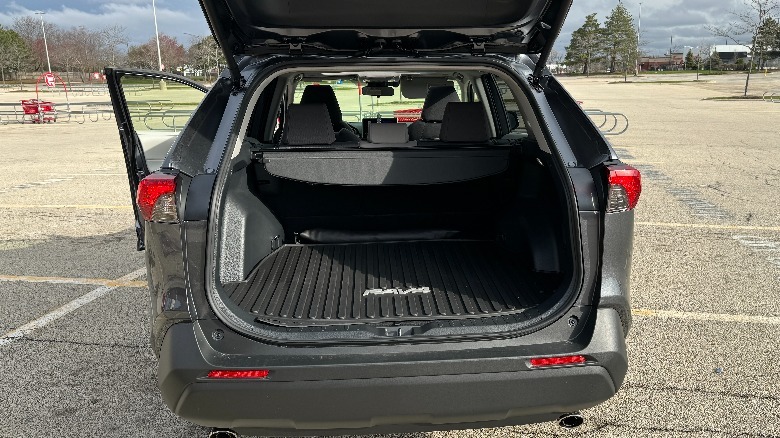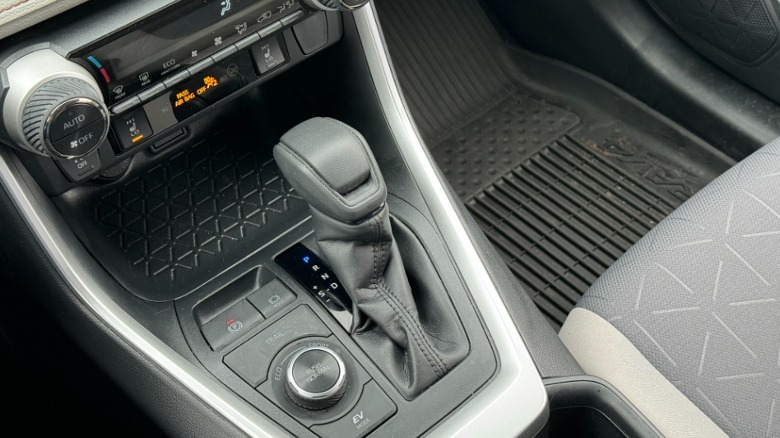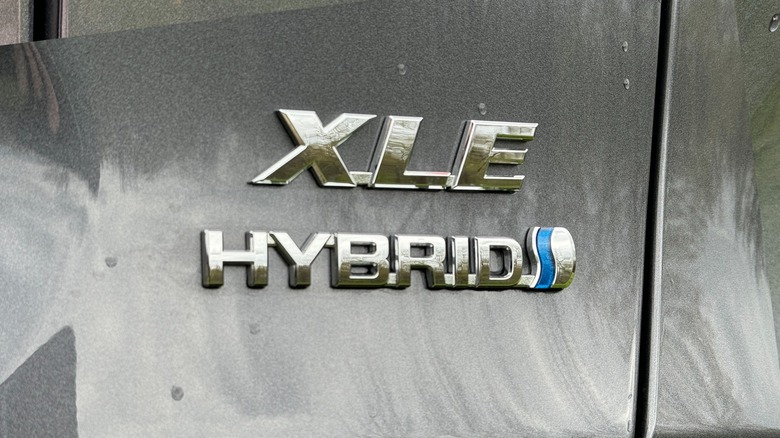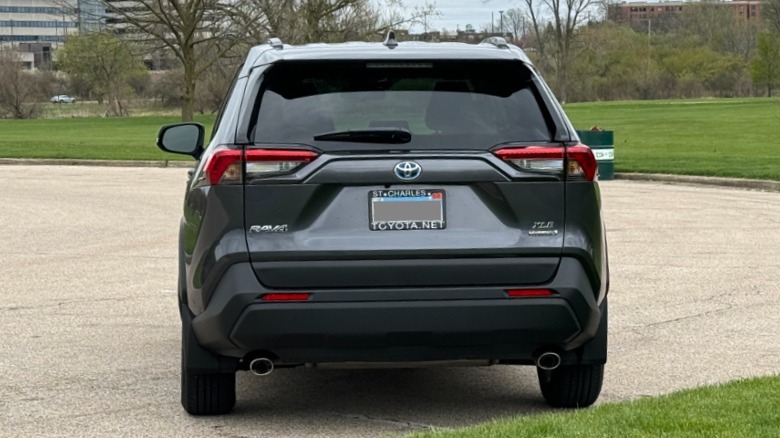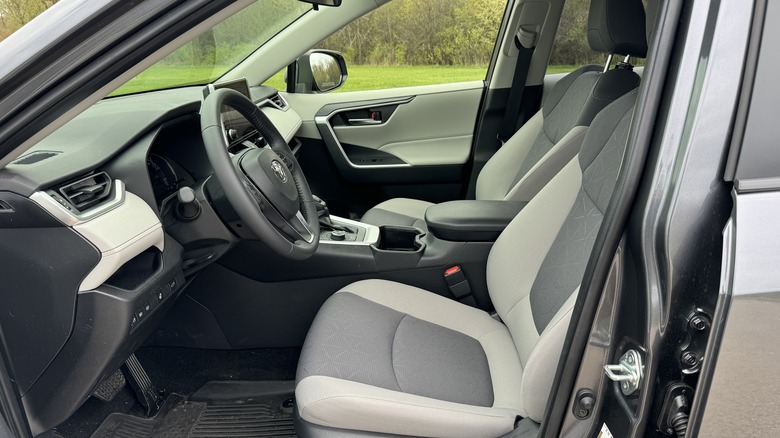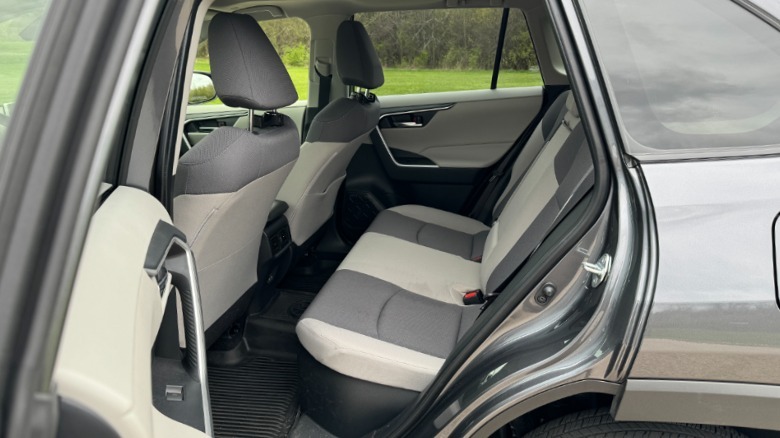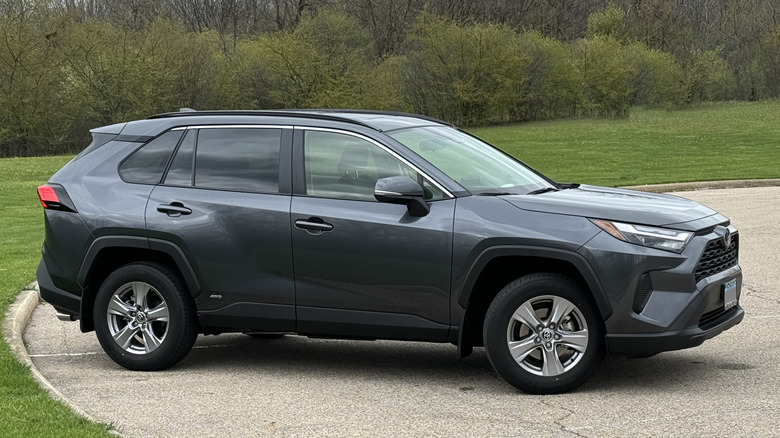2024 Toyota RAV4 Hybrid XLE Review: Smart, Affordable, And Boring By Design
- Affordable hybrid with great gas mileage
- Lots of standard features
- Great cargo space
- Excellent warranty and reliability
- App connectivity
- Not particularly sporty or ready for adventure
- App is limited
Picking a new car can be as challenging as dating, but as a two-car family recently reduced to just one vehicle, it was time to go shopping. Like most families, our priorities were high gas mileage, availability, comfort, and a few extra goodies to play with, not to mention price, reliability, and a solid warranty. As you've undoubtedly guessed, the 2024 Toyota RAV4 Hybrid was the winning model, but the process for navigating that selection–amid the rise in electrification, among other factors–bears exploring.
In a perfect world, we'd have started shopping in a few years, when EV infrastructure had grown and prices dropped. As it stands today, EVs that don't bear the Tesla badge are sorely lacking in those departments, and that was a brand I'd already dismissed for broader reasons. We also considered both hybrids and plug-in hybrids but, at the end of the day, PHEVs started a little out of our price range.
As a homeowner, with the potential for adding home charging, and a typical daily commute of around 25 miles, a PHEV makes a lot of sense; sadly, our budget disagreed. So, we put 40+ mpg high on our wishlist, and found a few hybrids matched our use case. Including the newest RAV4, that meant three primary contenders.
The top three hybrid contenders
Though my wife had reservations, I was keen to check out the Ford Maverick Hybrid. Maybe it's my romanticism for El Caminos in from 80s, or the fact that my father was a contractor who always drove a truck, but I really wanted to like Maverick. Not needing to borrow or rent a truck if we wanted to move a couch or buy some plywood was another bonus. After a test drive, though, it didn't feel right: The seats weren't comfortable, and the warranty wasn't where we wanted it to be.
Our next contender was a Kia Niro or Sportage. Either hybrid would've been okay, and the Sportage matched the RAV4 in how it drove, not to mention having useful (and fun) extras like parking assistance which backs the car out of a tight parking space using the buttons on the key fob. At the end of the day, though, friends and co-workers all recommended the Toyota. The litany of warranty horror stories on Reddit, a lack of Sportage inventory, and the disorganization of our local dealership sealed the decision.
The XLE Trim was the one for us
Toyota has seven RAV4 Hybrid trims to choose from, starting at $31,725 (plus destination) for the LE, rising to $40,030 for the Hybrid Limited trim. At $33,235 (plus destination), the XLE trim–plus the $2,190 convenience and all-weather package added–was our pick, with a power liftgate, heated seats and steering wheel, and sunroof. While we missed the bird's-eye view camera, and the two-position memory seats, they'd have added another $4,000 to the price. All told, we left the dealership a hair under our $40,000 budget, after taxes and everything else.
Our other feature priorities came standard with the car, like Toyota Safety Sense 2.5: It includes adaptive cruise control, which is an absolute joy in bumper-to-bumper traffic for three hours after a twice-in-a-lifetime celestial event.
Also standard is the Toyota App, from which you can lock, unlock, and remote start the car, and get alerts should you leave your windows or sunroof open. You can't actually close them with the app, though, and an even bigger limitation is that only one account holder can connect to the car. For a family vehicle where it's likely more than one person will be using it regularly, that's ridiculous.
A little boring, a little blue
Aesthetically, the RAV4 is everything you'd expect of a suburban family hauler. It has a boxy quality that might not be the most aerodynamic but maximizes cargo space on the inside. Indeed, the 37.6 cubic feet of cargo space with the rear seats up (or 69.8 cu-ft with them down) are among the best in class.
From the front, the RAV4 looks like a car that's having a bad day. The headlights angle downward like angry eyebrows, either side of a front grill that looks like it's frowning. The Toyota logos have a blue "glow" to reflect that this is the electrified model. Like the 2024 Corolla Cross Hybrid, the 2024 RAV4 Hybrid uses Toyota's fifth-generation hybrid drivetrain that combines a lithium-ion battery with a 2.5L 4-cylinder engine good for 219 horsepower overall and 184 lb-ft of torque.
There are four driving modes–Eco, Normal, Sport, and Trail–but I can't honestly say I can tell the difference between them. All seem spritely and ready to jump if I hit the gas hard. Mostly I've kept the SUV in Eco mode, since I am a 47-year-old suburban dad and I love fuel economy. The EPA estimates this model should achieve 41 mpg city, 38 mpg highway, and 39 mpg combined; after around 1,000 miles of my own mixed driving, the RAV4 claims to be at 37 mpg.
Your typical suburban dad-mobile
Despite the fact that the RAV4 Hybrid is available in a Woodland edition trim, and the XLE Hybrid comes with a "Trail" drive mode, Toyota's SUV definitely feels more at home in a Target parking lot than off-roading. While the pickup of the electrified drivetrain is attractive, there's nothing particularly exciting about the steering or the handling.
That's not to say the steering feel is lacking: the suspension is poised and compliant in turns, and the RAV4's turning circle is admirably tight. Sure, you can definitely find yourself driving faster than intended if you jump off the line at a stoplight, but that's about as exciting as the driving experience gets. Like other electrified vehicles, there's a Jetsons-like sound effect when driving in EV mode; it gets louder when you're reversing, thanks to the pedestrian safety regulations, since that relies on the electric motor.
The switch between EV driving and when the gas engine kicks in is super smooth—you probably won't notice it in feel, though you'll hear the engine spring to life when needed. It's not as off-putting as it is in the Corolla Cross: All the engine sounds here match up with what you're trying to make the SUV do.
A little cramped on the inside, if you're big
At 6 feet tall and on the wrong side of 300 pounds, when I describe the inside of the RAV4 as a tad cramped, I'm definitely a niche case. I can sit comfortably in any seat—front or back—but in the front passenger seat in particular, I need to recline the backrest more than usual to keep my head clear of the roof. A prominent center console, along with lower-than-expected door grips, can also intrude on knee space. There are plenty of storage bins as a result, but if you're any bigger than me you might have trouble getting comfortable, especially on long trips.
The 8-inch infotainment touchscreen sounds small on paper, but the size turned out to be quite delightful: Enough real estate to make sure buttons aren't on top of each other, navigation space is plentiful, and the touchscreen itself is responsive. Wireless Android Auto and Apple CarPlay are standard across all trims, though connecting the phone can be finicky at times, especially when two paired phones get in the car at the same time. There are three USB ports in the front—one USB-A on the dashboard, and two USB-C under the armrest–and two USB-C ports in the rear for charging.
Below the touchscreen, there are physical controls for climate control and the heated front seats. The steering wheel has a bevy of buttons for everything from music selection to the dashboard menu to cruise control. Despite the overall number, the controls feel intuitive, though Toyota still feels the need to throw a bunch of extra buttons to the left of the steering wheel for high-beam headlights, screen brightness, and more.
2024 Toyota RAV4 Hybrid Verdict
The verdict by this point should be fairly obvious—we bought the car. I described the RAV4 Hybrid to a friend of mine as "we finally got a car that we wanted, not just one we could live with." Had the latter been the main priority, the Chevrolet Trax doesn't have a hybrid option and its gas mileage isn't the best, but it starts at about 60% of the final price we paid for the Toyota.
Like a lot of people shopping for a new car, our decision was dictated in a large part by budget. The 2024 RAV4 Hybrid XLE isn't the very best SUV you can buy–Toyota's own higher trims come with more luxury features, for a start– but it's a compelling offering at its price point. The same could be said for the 2024 Kia Sportage, too, at almost the same price (in fact, the Kia is around $1,000 less) but the RAV4 comes with Toyota's fifth-generation hybrid powertrain, a reminder that the automaker has been at this electrification business for a while, now.
Add to that Toyota and the RAV4's reliability and reputation, and while there's invariably room for improvement, for the price it's hard to complain.
